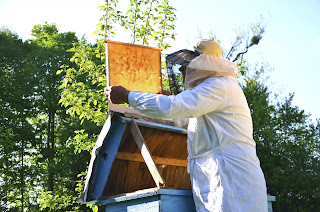The winter months often bring some wear and tear on fencing, so be sure to walk your fence line once spring arrives to assess any damages. If you have an electric fence, do a test run on your energizer to make sure everything is working properly. You can also use a live fence indicator that permanently attaches to your fence line and flashes to show everything is working as it should be. The ground is softest and easiest to work with during springtime, so take advantage by doing any repairs or building now.
Barbed Wire vs. Electric Fencing
In today’s farming world, the choice between barbed wire and electric fencing is largely dependent on what its uses are going to be. For many farms with animals, electric fencing is the predominant choice. It’s cost effective, both in materials and in labor, and is usually the safer option. In addition, it’s more effective and versatile as well as easier to maintain and longer lasting than most barbed wire fencing. There are limits, such as the risk of dangerous shocks, damage from thunder and lightning storms and complications from heavy vegetation growth, however, in most cases, electric fencing will likely be your best bet.
Barbed wire fencing options may be best for keeping intruders out of large properties and can be relatively cheap – however, the increased risk of injury both to animals and humans often negates the initial cost savings.
Types of Electric Fencing
There are four main types of electric fencing available today:
- Electrified high-tensile wire fencing: The high carbon steel in this fence provides strong, long-lasting security and reduces elongation (sagging). In addition, it is resilient, versatile and low maintenance. This type of fencing requires fewer posts, making it less expensive than other types of electric fencing. This is the best option for installing a permanent fence over a large area. This fence option should be avoided, however, when containing fast-moving animals like horses, as running into it at full speed could cause serious injury.
- Electric poly rope fencing: This type of fencing is thick and reinforced with stainless steel, making it an effective conductor. It is good for areas with high winds and is rust-free.
- Electric poly tape fencing: This fencing option is a highly visible, strong, rust-free type of fence that is available in three widths: 12, 20 and 40mm.
- Electric poly wire fencing: This type of fencing is available on a reel, making it convenient for temporary fencing needs like subdividing pastures. It is also highly visible for animals.
If you decide on an electric fence for your fencing needs, you’ll need to consider the energizer you’re going to purchase. This depends, of course, on the type of electric fence you’re using, but a few considerations should be:
- The larger the area, the larger the energizer you’ll need
- The need for a permanent energizer versus a portable energizer
- The power source – 110 or 220-volt plug-in is usually best
- The joule rating – this measures the stored energy in an energizer; fences require 1 joule of output per mile of fencing
One of the most common issues electric fence owners have with their power fencing is inadequate grounding. Proper grounding is critical for the electric current to keep animals contained and predators out. A rule of thumb is to use three feet of grounding rods for every joule of energizer output. So for a 3-joule energizer, you’ll need nine feet of ground rods.
When thinking about your animals’ safety, fence construction is a very important consideration and one that you should look into based on the type of animal you need to contain and the fencing option you’re looking at. Electric fences are generally a safe option, as the pulse runs through the fence every second (or less) meaning that the animal has time to get away after it has been shocked.
If you have a barbed wire fence, one thing to be aware of: Connecting a power fence energizer to it is not recommended. Barbed wire fences increase the chances of an animal getting tangled and stuck, and a power barbed wire fence would then lead to repeated shocks. Although it is unlikely that these repeated shocks would seriously injure or kill the animal, it would cause unnecessary stress and is best avoided entirely.
Fencing is an important part of farm life, and one that requires careful consideration. Feel free to reach out to us at Paris Farmers Union with any questions you may have about what is best for your farm.









